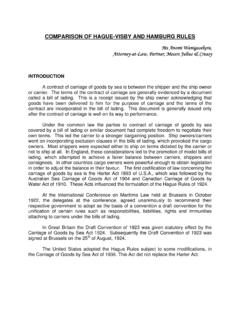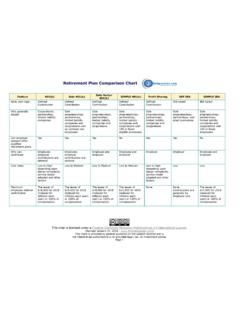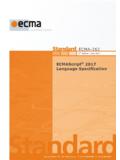Transcription of 2003 UPC/IPC Comp - IAPMO Group
1 *Abifbih i i i l dd h d fhiAl C i lih i iil blDATE:August 2003TO:Code Enforcement Officials, Members of Plumbing Code AdoptionBoards, and Interested Members of the Plumbing CommunityFROM:Edward Saltzberg,* PE, CEM, CIPEJ. Richard Wagner,* PE, CIPERE: 2003 International Plumbing Code/Uniform Plumbing Code ReviewThe following is a general review of the 2003 versions of both the International PlumbingCode and the Uniform Plumbing Code. The review was prepared by EdwardSaltzberg, PE, CEM, CIPE, and J. Richard Wagner, PE, CIPE. The review wasundertaken with the health and safety of the consumer as the prime , other factors considered in our review were the life cycle cost of systems, theease of enforcement, clarity of the code, plumbing engineering criteria, and any otherreservations that the writers may have had concerning the respective provisions of thetwo codes.
2 This review is not intended as a paragraph by paragraph comparison ofthe two code documents, but merely a comparison of the significant variationsbetween the two documents and was modified from our 2000 code review. Therefore,we have used a vertical line ( | ) in the margin to indicate a change from the 2000review and an arrow ( ) in the margin to indicate a deletion from the 2000 The Preface to the 2003 IPC declares that it is fully compatible with allInternational Codes. This is not true. The various I Codes areadministered by different committees who do not always agree on thesame issues.
3 The International Residential Code is an example withregards to plumbing. In very few cases do the referenced I Codes provide any specific technical requirements to supplement the IPC. The UPC tries to incorporate sufficient portions of other documents to be a stand alone document. 1 ADMINISTRATION 1 Scope. The IPC does not apply to plumbing in one andtwo family dwellings, although it includes references thereof. TheInternational Residential Code (IRC) covers plumbing in one andtwo family dwellings (where adopted). It refers to the ICC ElectricalCode for temporary power in Chapter 1 Administration, but hassection by section references to the NEC (NFPA 70) in its Appendix 33 through 42 of the IRC are based on the NEC instead of theICC Electrical Code.
4 The UPC does not reference the NEC in Chapter 14 but does include residential plumbing as part of the IPC/UPC Comparison21 IPC section states, This code shall also regulate nonflammablemedical gas, inhalation anesthetic, vacuum piping, non medical oxygensystems and sanitary and condensate vacuum collection systems. Theinstallation of fuel gas distribution piping and equipment, fuel gas firedwater heaters and water heater venting systems shall be regulated bythe International Fuel Gas Code. Provisions in the appendices shall notapply unless specifically adopted. However, IPC Chapter 12 Special Piping & Storage Systems has notechnical requirements and simply refers to other codes and standards.
5 Itrefers to NFPA 99C for medical gas and vacuum systems, but does notreference NFPA 99 Health Care Facilities, which is the parent document ofNFPA 99C and is an equivalent standard for medical gas and UPC includes medical gas systems, fuel gas systems and water heaters and heater venting all within the body of the Section Fuel gas piping is no longer regulated by the gas piping is within the scope of the UPC. Even though the National Fuel Gas Code is referred to gas piping is included in the Section , Referenced codes and standards. The code indicatesthat those codes listed in Chapter 13 are considered part of therequirement of this code and, therefore, an enforcement agent musthave copies of all of those codes and become thoroughly familiar UPC attempts to have as much as possible within the body ofthe code and not refer to or incorporate other codes as part of theUPC.
6 The 2003 UPC contains approximately 413 pages, comparedto 142 pages in the 2003 Section , Liability. This section removes any liability fromemployees. However, from a legalistic standpoint, this section may notbe valid. Such matters are usually left to legal staff of the authorityhaving UPC does not include such a Section , Rule-making authority. This section gives the codeofficial the authority to adopt and promulgate rules and regulationsregarding the UPC does not address rule making by the AdministrativeAuthority. Such authority is normally included in the ordinance thatcreated the Administrative Authority and/or in the adoptingordinance for the plumbing IPC/UPC Comparison31 Section , Modifications, and , Alternative materials, methodsand equipment.
7 This section is essentially the same as what is includedunder UPC Section , Alternate Materials and Section 109, MEANS OF APPEAL. This section provides means ofappealing the decision of the code official. It includes the appeal board,board membership, qualification of members, board officers, meetings,and open UPC does not address the filing of appeals and theadministration of an appeal board. Such authority is normallyincluded in the ordinance that created the Administrative Authorityand/or in the adopting ordinance for the plumbing other matters of administration, the IPC and UPC have similarrequirements and address those issues that need to be in theAdministrative chapter of a plumbing code.
8 2 DEFINITIONS2 Section 202, GENERAL DEFINITIONS ACCEPTED ENGINEERINGPRACTICE. The IPC includes a definition for this phrase and the UPC Section 202, GENERAL DEFINITIONS ALTERNATIVE ENGINEEREDDESIGN. The last sentence of the IPC definition indicates "The systemdesign is not specifically regulated by Chapters 3 through 12". Therefore,as part of any new design, an engineer would have to include all of theappropriate sections of the codes that were to still be enforced as part ofhis/her submission to give the code official something with which toinspect and approve the alternative engineered design, as the entirebody of the IPC has been deleted by this UPC includes alternative engineering methods under , Alternate Material and Methods which still requirescompliance with the remaining provisions of the Section 202, GENERAL DEFINITIONS FLOOD HAZARD AREA.
9 The IPCdefines flood hazard area. While the definition seems clear, there aremany areas where locations are not normally subject to 1% flooding butcould be during heavy rainstorms where runoffs could have high velocitywater. Therefore, from an engineering standpoint it would be somewhathard to define which zone a specific building is located UPC does not contain this confusing 3 GENERAL REGULATIONS3 Section , Installation of materials. The material manufacturer'sinstallation instructions are superseded by the installation provisions of thestandard for that particular material.
10 This could prevent a manufacturerfrom dictating the installation requirements for a specific material orproduct for which it is IPC/UPC Comparison4 UPC Section requires that material be installed according tothe code and the manufacturers recommendations. If there areconflicts, the more stringent is Section , Third-party testing and certification. The IPC haschanged from requiring plumbing products and materials to be labeledby an approved agency to having them either tested or certified by athird party as indicated in Table The IPC defines "third-partycertification agency", "third-party certified", and "third-party tested", but itdoes not define the relationship between the third party and the first andsecond Section requires that all pipe, pipe fittings, traps, fixtures,material, and devices used in a plumbing system must be listed orlabeled by a listing agency.














